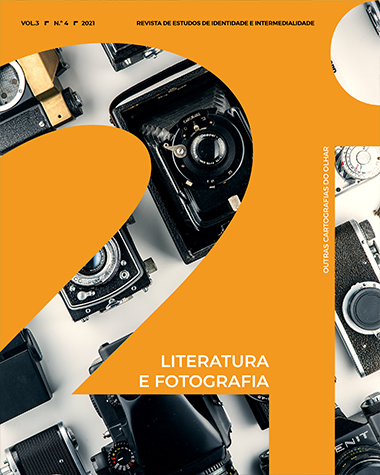Contemporary photography practice: From landscape to expanded modes of place representation
DOI:
https://doi.org/10.21814/2i.3455Keywords:
Aotearoa New Zealand, Waikato River, Contemporary practice photography, Place, LandscapeAbstract
Contemporary photographic practice has evolved into a broad field of possibilities, a flux of representational modes that represent emotions, experiences and feelings. In parallel the depth and layering of places offers a stimulating challenge to researchers and artists whom are willing to creatively explore nuances of land and nature as well as the multi-sensorial and spatial “reality” of places. The Waikato River is my research locale, located in the central North Island of Aotearoa New Zealand. I draw on contemporary photography practice and theory to develop multimodal approaches to my research place, expanding objective modes of landscape and place representation. I trace a timeline from early landscape photography practice particularly during the British colonisation in New Zealand juxtaposing my photography practice as a counter approach to Eurocentric modes of place representation. This is informed by local Waikato Māori cosmologies and more contemporary readings on place. As a result I conceptualised a theoretical framework around the notion of place imaginaries as a creative platform for the development of expanded photographic modalities.
Downloads
References
Anderson, B., & Harrison, P. (2010). The Promise of Non-Representational Theories. In Taking-Place: Non-Representational Theories and Geography: Non-Representational Theories and Geography. Taylor & Francis Group. http://ebookcentral.proquest.com/lib/aut/detail.action?docID=539832
Belich, J. (1986). The New Zealand Wars and the Victorian interpretation of racial conflict. Auckland University Press.
Bender, B. (1993). Landscape: Politics and perspectives. Berg.
Boast, R., & Hill, R. S. (Eds.). (2009). Raupatu: The confiscation of Māori land. Victoria University Press.
Bright, S. (2011). Art photography now (2nd ed.). Thames & Hudson.
Cook, D. B., Puke, W., & Valentine, J. (2011). River/road: Journeys through ecology. Rim Books.
Cosgrove, D. (1985). Prospect, perspective and the evolution of the landscape idea. Transactions of the Institute of British Geographers, 10(1), 45–62. https://doi.org/10.2307/622249
Dench, S. (2011a). Invading the Waikato: A postcolonial re-view. New Zealand Journal of History, 45(1), 33–49.
_____ (2011b). Representing the Waikato: Photography and colonisation. Journal of New Zealand Literature, 29(2), 66–88.
Edge, S. (2013). Photography and poststructuralism: The indexical and iconic sign system. In B. Dillet, L. Mackenzie, & R. Porter (Eds.), Edinburgh companion to poststructuralism (pp. 311–332). EUP.
Edwards, E. (2011). Tracing photography. In J. Ruby & M. Banks (Eds.), Made to be seen: Perspectives on the history of visual anthropology (pp. 159–189). University of Chicago Press. http://site.ebrary.com/lib/alltitles/docDetail.action?docID=10519583
_____ (2012). Objects of Affect: Photography Beyond the Image. Annual Review of Anthropology, 41, 221–234. JSTOR. http://www.jstor.org/stable/23270708
_____ (2015). Anthropology and Photography: A long history of knowledge and affect. Photographies, 8(3), 1–18. https://doi.org/10.1080/17540763.2015.1103088
Fenton, R. (1860). The Long Walk Windsor [Photograph]. www.royalcollection.org.uk/sites/default/files/collection-online/f/1/435998-1387192544.jpg
Fisher, M. (2016a). ‘I riro whenua atu me hoki whenua mai’: The return of land and the Waikato-Tainui raupatu settlement. Journal of New Zealand Studies, 23, 19–36.
_____ (2016b). The politics of history and Waikato-Tainui’s Raupatu Treaty Settlement. New Zealand Journal of History, 50(2), 68–89.
Flusser, V. (2000). Towards a philosophy of photography. Reaktion.
Fontcuberta, J. (2015). The Post-Photographic Condition | Anti-Utopias (S. Bors, Interviewer) [Interview]. https://anti-utopias.com/newswire/post-photographic-condition/
Ghirri, L. (2017). The complete essays 1973-1991. MACK.
Glowczewski, B. (2012). From academic heritage to Aboriginal priorities: Anthropological responsibilities. Revista de Antropologia Da UFSCar, 4(2), 6–19. https://researchonline.jcu.edu.au/33208/1/33208%20Glowczewski%202011.pdf
Hill, R. (2018). South of the Rising Sun / Whakatetonga o te Whitinga o te Rā [Photography Installation].
_____ (2019). Place imaginaries: Photography and place-making at Te Awa River Ride [Thesis, The University of Waikato]. https://researchcommons.waikato.ac.nz/handle/10289/12797
_____ (2021). Contemporary Photography Practice:Expanded Methidology and Critical Ways of Thinking. Design, Art and Technology Journal, 6(2). https://datjournal.anhembi.br/dat/issue/view/16/18
Ingersoll, K. E. (2016). Waves of knowing: A seascape epistemology. Durham; London Duke University Press.
Jazeel, T. (2012). Postcolonialism: Orientalism and the geographical imagination. Geography, 97(1), 4–11. http://www.jstor.org/stable/24412174
_____ (2019). Postcolonialism. Routldge.
Kapā’anaokalāokeola Nākoa Oliveira, K.-A. R.-M. (2014). Ancestral places: Understanding Kanaka geographies. Oregon State University Press.
King, C. M., & Roa, T. om. (2015). The Maori of the Central North Island before 1860. In C. M. King, D. J. Gaukrodger, & N. A. Ritchie (Eds.), The drama of conservation: The history of the Pureora Forest, New Zealand (pp. 43–66). Department of Conservation, NZ & Springer International. https://doi.org/10.1007/978-3-319-18410-4_3
Kolenda, K. (2019). Aestheticising the Post-Industrial Debris: Industrial Ruins in Contemporary British Landscape Photography. Revue LISA/LISA e-Journal. Littératures, Histoire Des Idées, Images, Sociétés Du Monde Anglophone – Literature, History of Ideas, Images and Societies of the English-Speaking World, vol. XVII-n°1, Article XVII-n°1. https://doi.org/10.4000/lisa.11083
Kossoy, B. (2001). Fotografia & história (2a edição revista.). Ateliê Editorial.
Massey, D. B., Allen, J., & Sarre, P. (Eds.). (2007). Human geography today. Polity Press.
Mataira, K. (1983). The river which ran away. Ahuru Press.
Muru-Lanning, M. (2016). Tupuna Awa: People and politics of the Waikato River. Auckland University Press.
Park, G. (2006). Theatre country: Essays on landscape and whenua. Victoria University Press.
Peden, R., & Holland, P. (2015). Settlers tranforming the open country. In E. Pawson & T. Brooking (Eds.), Making a new land: Environmental histories of New Zealand (pp. 89–105). Otago University Press.
Puke, W. (2011). The Te Araroa Waikato River Walkway investigation report. NaMTOK Consultancy.
Radcliffe, S. A. (2017). Decolonising geographical knowledges. Transactions of the Institute of British Geographers, 42(3), 329–333. https://doi.org/10.1111/tran.12195
Salmond, A. (2017). Tears of Rangi: Experiments Across Worlds. Auckland University Press.
Schwartz, J. M. (1996). The Geography Lesson: Photographs and the construction of imaginative geographies. Journal of Historical Geography, 22(1), 16–45. https://doi.org/10.1006/jhge.1996.0003
Schwartz, J. M., & Ryan, J. R. (Eds.). (2003). Picturing place: Photography and the geographical imagination. I.B. Tauris.
Setten, G. (2010). Landscapes of gaze and practice. Norsk Geografisk Tidsskrift - Norwegian Journal of Geography, 57(3), 134–144. https://doi.org/10.1080/00291950310002116
Shore, R. (2014). Post-photography: The artist with a camera. Laurence King Publishing.
Smith, L. T. (2012). Decolonizing methodologies: Research and indigenous peoples (2nd ed). Zed Books.
Stewart, P. J., & Strathern, A. (Eds.). (2003). Landscape, memory and history: Anthropological perspectives. Pluto.
Te Aho, L. (2008). Contemporary issues in Maori law and society: The tangled web of treaty settlements, emissions trading, Central North Island Forests, and the Waikato River. Waikato Law Review: Taumauri, 16, 229–250. http://search.informit.com.au.ezproxy.waikato.ac.nz/documentSummary;dn=691109257960927;res=IELHSS
Thrift, N. J. (1996). Spatial formations. Sage.
_____ (2008). Non-representational theory: Space, politics, affect. Routledge.
Tūrangawaewae Board of Trustees. (2011). Tōku Tūrangawaewae: Our stories celebrating our 90th year, 12 August 2011. Tūrangawaewae Trust Board.
Waikato Raupatu Lands Trust. (2008). Waikato Raupatu River Settlement: Information package, August 2008. Author.
Waterton, E. (2019). More Than Representational Landscapes. In P. Howard, I. Thompson, M. Atha, & E. Waterton (Eds.), The Routledge Companion to Landscape Studies (2nd ed., pp. 91–101). Routledge. https://doi.org/10.4324/9781315195063
Wells, L. (Ed.). (2004). Photography: A critical introduction (3rd ed.). Routledge.
_____ (2011). Land matters: Landscape photography, culture and identity. I. B. Tauris.
Whitridge, P. (2004). Landscapes, houses, bodies, things: “Place” and the archaeology of Inuit imaginaries. Journal of Archaeological Method & Theory, 11(2), 213–250. https://doi.org/10.1023/B:JARM.0000038067.06670.34
Downloads
Published
How to Cite
Issue
Section
License
Copyright (c) 2021 Rodrigo Hill

This work is licensed under a Creative Commons Attribution-NonCommercial 4.0 International License.


.jpg)










